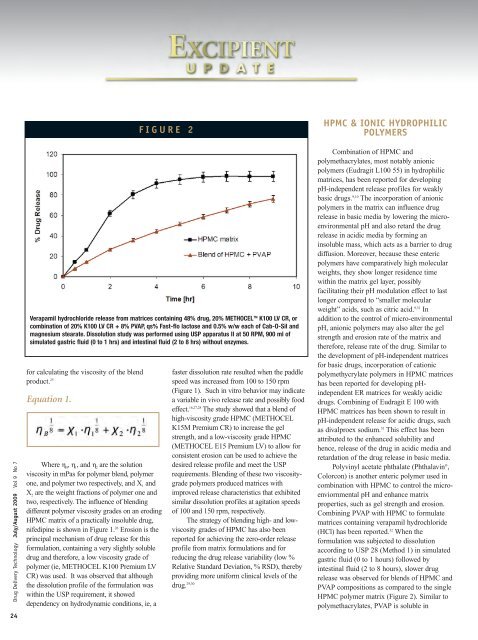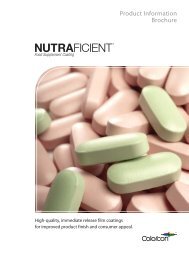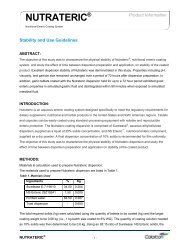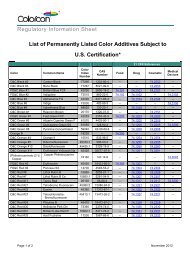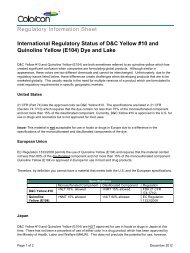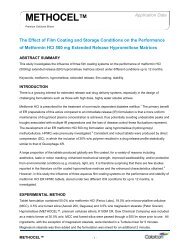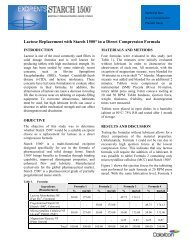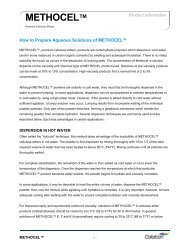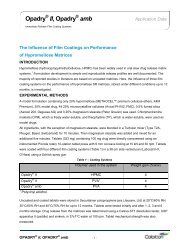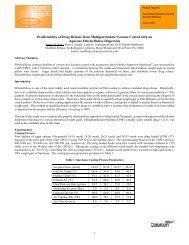Applications of Complementary Polymers in HPMC ... - Colorcon
Applications of Complementary Polymers in HPMC ... - Colorcon
Applications of Complementary Polymers in HPMC ... - Colorcon
You also want an ePaper? Increase the reach of your titles
YUMPU automatically turns print PDFs into web optimized ePapers that Google loves.
Drug Delivery Technology July/August 2009 Vol 9 No 7<br />
24<br />
for calculat<strong>in</strong>g the viscosity <strong>of</strong> the blend<br />
product. 25<br />
Equation 1.<br />
Where h B<br />
, h 1<br />
, and h 2<br />
are the solution<br />
viscosity <strong>in</strong> mPas for polymer blend, polymer<br />
one, and polymer two respectively, and X 1<br />
and<br />
X 2<br />
are the weight fractions <strong>of</strong> polymer one and<br />
two, respectively. The <strong>in</strong>fluence <strong>of</strong> blend<strong>in</strong>g<br />
different polymer viscosity grades on an erod<strong>in</strong>g<br />
<strong>HPMC</strong> matrix <strong>of</strong> a practically <strong>in</strong>soluble drug,<br />
nifedip<strong>in</strong>e is shown <strong>in</strong> Figure 1. 26 Erosion is the<br />
pr<strong>in</strong>cipal mechanism <strong>of</strong> drug release for this<br />
formulation, conta<strong>in</strong><strong>in</strong>g a very slightly soluble<br />
drug and therefore, a low viscosity grade <strong>of</strong><br />
polymer (ie, METHOCEL K100 Premium LV<br />
CR) was used. It was observed that although<br />
the dissolution pr<strong>of</strong>ile <strong>of</strong> the formulation was<br />
with<strong>in</strong> the USP requirement, it showed<br />
dependency on hydrodynamic conditions, ie, a<br />
F I G U R E 2<br />
Verapamil hydrochloride release from matrices conta<strong>in</strong><strong>in</strong>g 48% drug, 20% METHOCEL TM K100 LV CR, or<br />
comb<strong>in</strong>ation <strong>of</strong> 20% K100 LV CR + 8% PVAP, qs% Fast-flo lactose and 0.5% w/w each <strong>of</strong> Cab-O-Sil and<br />
magnesium stearate. Dissolution study was performed us<strong>in</strong>g USP apparatus II at 50 RPM, 900 ml <strong>of</strong><br />
simulated gastric fluid (0 to 1 hrs) and <strong>in</strong>test<strong>in</strong>al fluid (2 to 8 hrs) without enzymes.<br />
faster dissolution rate resulted when the paddle<br />
speed was <strong>in</strong>creased from 100 to 150 rpm<br />
(Figure 1). Such <strong>in</strong> vitro behavior may <strong>in</strong>dicate<br />
a variable <strong>in</strong> vivo release rate and possibly food<br />
effect. 16,27,28 The study showed that a blend <strong>of</strong><br />
high-viscosity grade <strong>HPMC</strong> (METHOCEL<br />
K15M Premium CR) to <strong>in</strong>crease the gel<br />
strength, and a low-viscosity grade <strong>HPMC</strong><br />
(METHOCEL E15 Premium LV) to allow for<br />
consistent erosion can be used to achieve the<br />
desired release pr<strong>of</strong>ile and meet the USP<br />
requirements. Blend<strong>in</strong>g <strong>of</strong> these two viscositygrade<br />
polymers produced matrices with<br />
improved release characteristics that exhibited<br />
similar dissolution pr<strong>of</strong>iles at agitation speeds<br />
<strong>of</strong> 100 and 150 rpm, respectively.<br />
The strategy <strong>of</strong> blend<strong>in</strong>g high- and lowviscosity<br />
grades <strong>of</strong> <strong>HPMC</strong> has also been<br />
reported for achiev<strong>in</strong>g the zero-order release<br />
pr<strong>of</strong>ile from matrix formulations and for<br />
reduc<strong>in</strong>g the drug release variability (low %<br />
Relative Standard Deviation, % RSD), thereby<br />
provid<strong>in</strong>g more uniform cl<strong>in</strong>ical levels <strong>of</strong> the<br />
drug. 29,30<br />
<strong>HPMC</strong> & IONIC HYDROPHILIC<br />
POLYMERS<br />
Comb<strong>in</strong>ation <strong>of</strong> <strong>HPMC</strong> and<br />
polymethacrylates, most notably anionic<br />
polymers (Eudragit L100 55) <strong>in</strong> hydrophilic<br />
matrices, has been reported for develop<strong>in</strong>g<br />
pH-<strong>in</strong>dependent release pr<strong>of</strong>iles for weakly<br />
basic drugs. 9,10 The <strong>in</strong>corporation <strong>of</strong> anionic<br />
polymers <strong>in</strong> the matrix can <strong>in</strong>fluence drug<br />
release <strong>in</strong> basic media by lower<strong>in</strong>g the microenvironmental<br />
pH and also retard the drug<br />
release <strong>in</strong> acidic media by form<strong>in</strong>g an<br />
<strong>in</strong>soluble mass, which acts as a barrier to drug<br />
diffusion. Moreover, because these enteric<br />
polymers have comparatively high molecular<br />
weights, they show longer residence time<br />
with<strong>in</strong> the matrix gel layer, possibly<br />
facilitat<strong>in</strong>g their pH modulation effect to last<br />
longer compared to “smaller molecular<br />
weight” acids, such as citric acid. 9,31 In<br />
addition to the control <strong>of</strong> micro-environmental<br />
pH, anionic polymers may also alter the gel<br />
strength and erosion rate <strong>of</strong> the matrix and<br />
therefore, release rate <strong>of</strong> the drug. Similar to<br />
the development <strong>of</strong> pH-<strong>in</strong>dependent matrices<br />
for basic drugs, <strong>in</strong>corporation <strong>of</strong> cationic<br />
polymethycrylate polymers <strong>in</strong> <strong>HPMC</strong> matrices<br />
has been reported for develop<strong>in</strong>g pH<strong>in</strong>dependent<br />
ER matrices for weakly acidic<br />
drugs. Comb<strong>in</strong><strong>in</strong>g <strong>of</strong> Eudragit E 100 with<br />
<strong>HPMC</strong> matrices has been shown to result <strong>in</strong><br />
pH-<strong>in</strong>dependent release for acidic drugs, such<br />
as divalproex sodium. 31 This effect has been<br />
attributed to the enhanced solubility and<br />
hence, release <strong>of</strong> the drug <strong>in</strong> acidic media and<br />
retardation <strong>of</strong> the drug release <strong>in</strong> basic media.<br />
Polyv<strong>in</strong>yl acetate phthalate (Phthalav<strong>in</strong> ® ,<br />
<strong>Colorcon</strong>) is another enteric polymer used <strong>in</strong><br />
comb<strong>in</strong>ation with <strong>HPMC</strong> to control the microenviornmental<br />
pH and enhance matrix<br />
properties, such as gel strength and erosion.<br />
Comb<strong>in</strong><strong>in</strong>g PVAP with <strong>HPMC</strong> to formulate<br />
matrices conta<strong>in</strong><strong>in</strong>g verapamil hydrochloride<br />
(HCl) has been reported. 32 When the<br />
formulation was subjected to dissolution<br />
accord<strong>in</strong>g to USP 28 (Method 1) <strong>in</strong> simulated<br />
gastric fluid (0 to 1 hours) followed by<br />
<strong>in</strong>test<strong>in</strong>al fluid (2 to 8 hours), slower drug<br />
release was observed for blends <strong>of</strong> <strong>HPMC</strong> and<br />
PVAP compositions as compared to the s<strong>in</strong>gle<br />
<strong>HPMC</strong> polymer matrix (Figure 2). Similar to<br />
polymethacrylates, PVAP is soluble <strong>in</strong>


